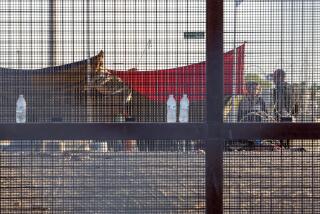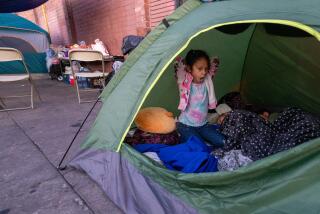More than 50 children wait to be allowed into ports of entry to request U.S. asylum

Some migrant children who traveled by themselves up to the U.S. border have not been allowed to request asylum despite assurances from federal immigration officials that they prioritize unaccompanied minors.
As a result, a backlog of children waiting to ask the U.S. for help has formed in Tijuana with many saying that they were turned away from ports of entry by U.S. and Mexican officials working together.
Though asylum seekers have had to queue in Tijuana for their turns to ask the U.S. for protection for well over a year, Customs and Border Protection has said that children traveling without an adult aren’t supposed to wait in line because it considers them a vulnerable group. Now, at least 50 children are in a line of their own.
Many have been waiting for months.
Nicole Ramos, an attorney working with Al Otro Lado, a legal services organization that supports migrants in Tijuana, said she first noticed youth having more difficulty getting to U.S. soil in August 2018 when Mexican immigration officials began intercepting migrant children before they reached the port of entry gates guarded by CBP.
Some ended up in custody of the National System for Integral Family Development, Mexico’s child protective services. Children from countries other than Mexico are often deported after they end up in that agency’s custody, Ramos said.
A representative for the agency did not respond to a voicemail left by the San Diego Union-Tribune.
Stories of migrant children who were traveling through Mexico getting caught by immigration officials and sent home have surfaced for years. Under Mexican law, minors cannot travel or leave the country without being accompanied by a legal guardian or parent.
Because of the recent interventions from Mexican officials at the ports of entry in Tijuana, some children have ended up staying long term at shelters around Tijuana, particularly at Casa YMCA, which takes only unaccompanied children. Others ended up homeless in the city, Ramos said.
In recent weeks, Ramos said, her organization was able to successfully escort children, a few at a time, through the ports of entry to CBP for processing. She prioritized children she felt were the most vulnerable, such as those who didn’t have a place to sleep.
Volunteers gave the kids clothes to make them look like middle-class children heading for a visit to the U.S. rather than migrant youth seeking asylum, in order to avoid confrontation with Mexican officials, Ramos said.
But then, March 21, three children accompanied by Al Otro Lado volunteers were again forced to turn back because of actions by Mexican and U.S. officials, Ramos said.
The children and volunteers arrived at El Chaparral, the port of entry on the Mexican side that connects to San Ysidro’s PedWest on the U.S. side, a little before 7 p.m., Ramos said.
An attorney among them spoke with U.S. officials who stood on the other side of a gate that marks the official border between the two countries, informing CBP that the three children — one from Mexico, one from Honduras and one from Guatemala — were unaccompanied minors seeking protection from the United States.
The officials asked the group to stand to one side and wait for a supervisor to come, Ramos said.
About 10 minutes later, a Mexican security official told the group to leave, Ramos said. The volunteers told him that they’d been instructed to stand there and wait.
One of the volunteers approached CBP again to ask how much longer they would need to wait for the supervisor. An official told them that because they were still in Mexico, they would need to listen to instructions from Mexican officials, Ramos said.
“The children would have been on U.S. soil but for the fact that CBP officers were preventing them from doing so,” Ramos said.
After more Mexican officials arrived, telling the group that they would call the police, the boys got scared about getting deported, Ramos said. The group had been at the entryway to the U.S. for about an hour, and the CBP supervisor still had not come.
In the end, the volunteers took the children back to the shelter where they had been staying in Tijuana.
“These children are incredibly psychologically damaged from being forced to wait for months in Tijuana and are growing desperate,” Ramos said. “Many discuss throwing themselves over the wall. It should not be that children must risk their lives because the adults in two governments cannot find it within themselves to act in accordance with federal and international law recognizing the rights of these children to migrate in search of protection.”
Volunteers escorting minors to the border experienced similar incidents late last year, which led Al Otro Lado to ask for members of Congress to accompany several children to the Otay Mesa Port of Entry in December.
Local Mexican officials declined to comment on the record about policies relating to unaccompanied minors.
When asked about incidents of children being turned away at the border, including the one in March, CBP pointed to the numbers of unaccompanied children the agency has processed over the last several months.
“CBP processes all individuals as expeditiously as possible while ensuring the execution of the agency’s overall mission and the safety of individuals within our custody,” a CBP spokesman said. “CBP processes all unaccompanied alien children who present themselves at and between the ports of entry and prioritizes their immediate intake and other vulnerable populations. The health and welfare of children at our borders is of utmost importance and their safety is of paramount concern while in our custody.”
According to data on its website, CBP officials along the California border have processed 950 unaccompanied children at ports of entry so far in fiscal year 2019. That’s up 61% from the 589 that came to California ports of entry during the same time period in fiscal 2018.
California ports of entry received more unaccompanied children in February, the month in which Ramos said more children were able to cross, than in any other month under the Trump administration.
Last week, Homeland Security Secretary Kirstjen Nielsen said that because of the numbers of families and unaccompanied children arriving, she would be diverting staff resources from other border security work to manage the arrivals. In a letter to Congress, she called on legislators to make it easier to deport unaccompanied children quickly.
Meanwhile, the American Civil Liberties Union published a report, along with a complaint to the Department of Homeland Security’s inspector general, that found that unaccompanied children, among other asylum seekers, are being turned away from ports of entry in Texas.
Ramos worries that more children will choose to cross illegally because they are tired of waiting and being turned back at the ports of entry.
A 15-year-old boy from Chiapas state in southern Mexico said he’s tried to approach U.S. officials at the San Ysidro Port of Entry a number of times. He was ignored, he said.
In mid-January, Mexican immigration officials stopped him when he was walking down a long hallway toward the U.S. inside the port and brought him to Casa YMCA.
The children staying at the shelter now are afraid to go outside its gates. Several of them knew two Honduran boys who were tortured and killed in Tijuana in December when the boys ventured out of the shelter.
“Tijuana feels dangerous,” a 16-year-old boy from Honduras said in Spanish. “I don’t want to be here.”
The children, mostly teens, do their best to distract themselves with skateboards, games and educational sessions, but the waiting is hard.
Their dreams for the future — for some it’s a career in chemistry or architecture, for others it’s simply finding a job and learning English — are what keep them going.
“I have a hope that I’ll be able to cross, and with God’s guidance, it will turn out well,” said a 17-year-old boy from Honduras who came with the caravan.
Morrissey writes for the San Diego Union-Tribune.
kate.morrissey@sduniontribune.com
More to Read
Start your day right
Sign up for Essential California for news, features and recommendations from the L.A. Times and beyond in your inbox six days a week.
You may occasionally receive promotional content from the Los Angeles Times.






